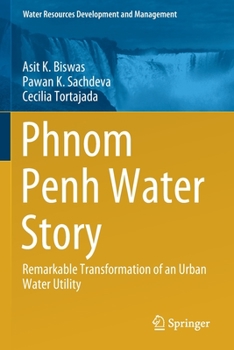Phnom Penh Water Story: Remarkable Transformation of an Urban Water Utility
Select Format
Select Condition 
Book Overview
SECTION I
Chapter 1 About this book
1.1 Book outline
1.2 Readership of the book
1.3 Background to writing of this book
1.4 Book structure
Chapter 2 Understanding Cambodia
2.1 Cambodia
2.1.1 Political background
2.1.2 Administrative arrangements in Cambodia
2.1.3 Cambodian economy
2.2 Phnom Penh
2.2.1 Population
2.2.2 Area of Phnom Penh
2.2.3 Physical conditions2.2.4 Economy
Chapter 3.
3.1 Phnom Penh Water Supply Authority
3.1.1 1959-1970: Period of expansion of water services (PPWSA 2020)
3.1.2 1970-1979: Period of conflict and instability3.1.3 1979-1993: Period of turbulence
3.1.4 1993-2012: Transformation phase
3.1.5 Donor's role in revival of PPWSA during 2003-2012
3.1.6 Listing of PPWSA stock in 2012: A vote of confidence
3.1.7 Transformation of PPWSA under Ek Sonn Chan
3.2 Changing of the guard: 2012-2017
Chapter 4 Four domain (4-D) framework for analysis of urban water utility
Chapter 5 PPWSA: Analysis
5.1 Physical domain of PPWSA
5.1.1 Rivers and seasonal direction of flow
5.1.2 Water treatment plants, their location and source of surface water
5.1.3 Phnom Penh's raw water requirement and prime source of raw water in 2016
5.1.4 Future raw water demand and location of new water treatment plants
5.1.5 Outlook on raw water for Phnom Penh
5.2 Operational domain of PPWSA
5.2.1 Capacity and production of treated water
5.2.2 Distribution of pipeline length
5.2.3 Performance of the water supply network
5.2.4 Non-revenue water and unaccounted for water
5.2.5 Water Supply and Sanitation Branch
5.2.6 Customer mix
5.2.7 Quality of water
5.2.8 Customer care5.2.9 Internal organisation structure and management team
5.2.10 Outlook on operational performance
5.3 Financial domain
5.3.1 Revenue mix
5.3.2 Production cost
5.3.3. Unit realisations
5.3.4 Financial ratios5.3.5 Social fund by PPWSA
5.3.6. Financial outlook
5.4 Regulatory domain
5.4.1 Water agencies in Cambodia
5.4.2 Ministry of Industry and Handicrafts
5.4.3 Water sector plans and policies
5.4.4 Regulatory outlooks
Chapter 6 Gap analysis of four domains
SECTION II
1 Introduction
2 Key learnings for water utilities in developing countries
2.1 Leadership
2.2 Stability of Chief Executive tenure and culture of the organisation
2.3 Autonomous institution
2.4 Non-revenue water reduction
2.4.1 Effective leaks repair
2.4.2 Updating customer base
2.4.3 Metering of all service connections
2.4.4 Fight against illegal connections
2.4.5 Standardised design of last mile service-connection
2.4.6 Gradual replacement of the old supply network
2.4.7 District metering area (DMA) programme
2.4.8 Introduction of internal service contracts
2.5 Data availability and reporting
2.6 Standardisation of treatment plant size
2.7 Connections to the poor
3 Key challenges for PPWSA and water services in Phnom Penh
3.1 Human resource planning and implementation in PPWSA
3.2 Phnom Penh Urban Master Plan3.3 Evolving regulatory domain
3.4 Lack of financial support to PPWSA from government sources 3.5 Lack of centralised sewerage system in Phnom Penh3.6 PPWSA listing on Cambodia Stock Exchange
4 Customer interviews





